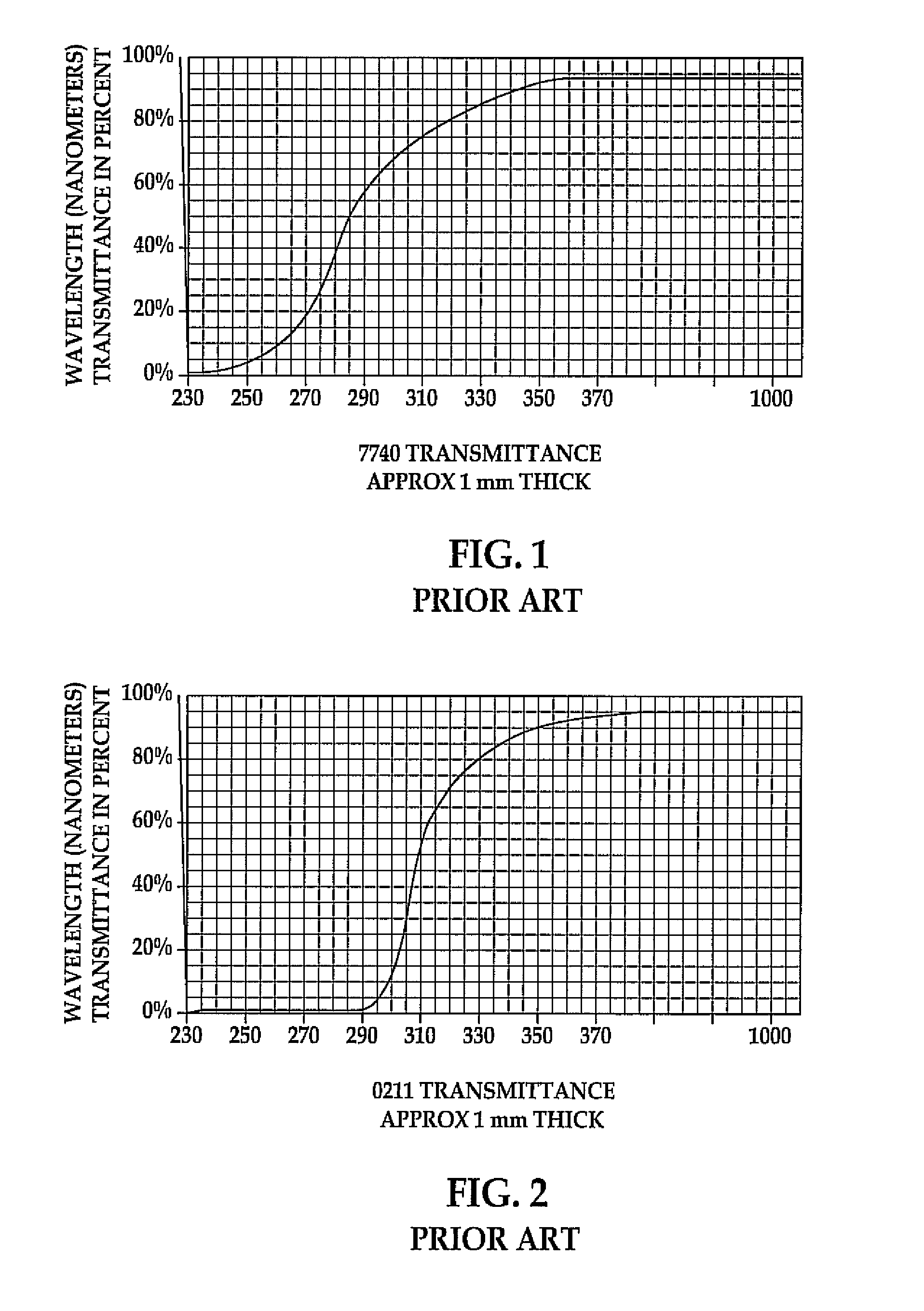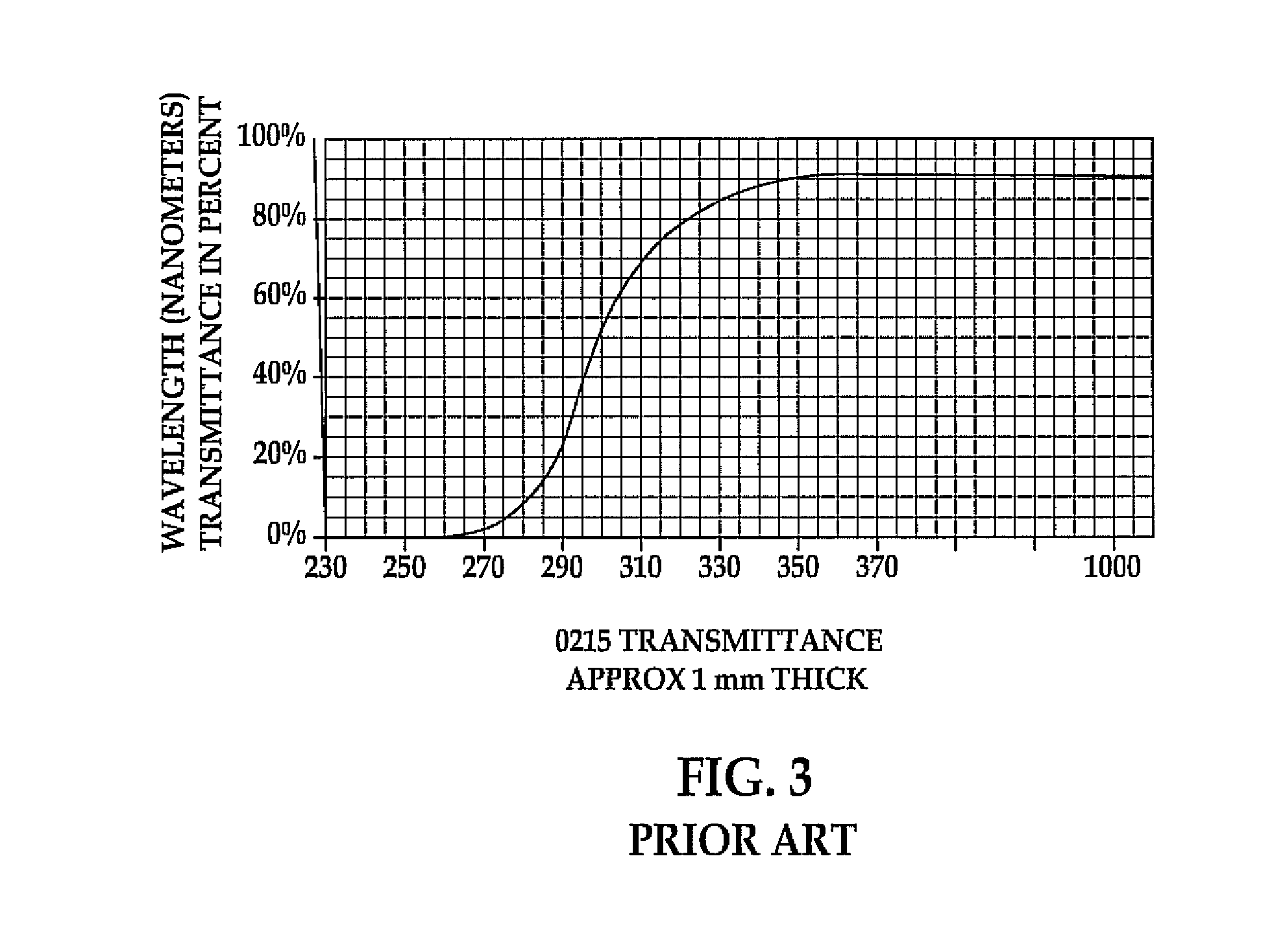Process of photomorphogenically enhancing plants
a plant and photomorphogen technology, applied in biochemistry apparatus and processes, horticulture, saving energy measures, etc., can solve the problems of early experiments performed under unrealistic spectral balances, reduced crop yields, and less well understood ultraviolet radiation role in promoting plant growth and survival, etc., to improve the level of ultraviolet radiation activating genes, improve fruit flavor characteristics, and thicken fruit skin
- Summary
- Abstract
- Description
- Claims
- Application Information
AI Technical Summary
Benefits of technology
Problems solved by technology
Method used
Image
Examples
example 1
[0041]Low expansion borosilicate glass suitable in the instant invention is commercially available (Pyrex 7740 borosilicate glass, Corning, Inc.). This glass has the spectral profile as shown in FIG. 1. This glass is manufactured in sheets with a low coefficient of expansion providing mechanical stability. This material is suitable for manufacture into sheets for glasshouse or other biological material growth.
[0042]Another material suitable in the instant invention is zinc titania glass (Corning, Inc.). The transmission profile of this glass is shown in FIG. 2. This glass is manufactured in small sheets at 1 mm thickness. This glass or other suitable glasses are optionally stabilized by a transparent or metal mesh to provide mechanical stability to the glass while maintaining the desired optical transmission and full light pass characteristics desired. In this fashion large sheets are produced that can be installed on a glasshouse. Alternatively, zinc titania or other glass is used ...
example 2
[0044]Borosilicate glass (Pyrex 7740) panes of 2 mm thickness used as high transmissibility, steep edge situation filters are placed in an aluminum frame. A combination array of different lamps including metal halide, quartz-halogen, blue fluorescent, and UV-B fluorescent lamps to provide the UVB portion of the spectrum (Seckmeyer, G., and Payer, H., J Photochem Photobiol, 1993; 21:175-81) are positioned opposite the inventive glass panes from soil containing a mixture of Levington Compost B2 and perliet (3:2). Ocimum basilicum L. is grown in the soil and exposed to illuminating conditions for 14 hours per day and cycled through darkness for the remaining 10 hours per day against a like control receiving no UV irradiation. After growth for 15 days, leaves are analyzed for anatomical characterization and quantitation of essential oil from developing and mature leaves as described by Ioannidis et al., 2002. UVB treatment leads to photomorphogenically increased essential oil production...
example 3
[0045]Soybeans are grown from seed under light as in Example 2 at 15 kJ / m2 / day UVB radiation and in standard greenhouse environmental conditions of temperature and humidity against a like UV irradiation free control. These photomorphogenic soybeans require much lower soil moisture levels as the root structure is enhanced under these growth conditions relative to controls. The photomorphogenic root to shoot ratio is significantly improved providing greater soil penetration and plant-soil interaction which in turn requires reduced water input to maintain growth parameters. These photomorphogenic plants also show increased dry weight mainly attributable to increase root mass. Further, the photomorphogenic relative leaf area ratio decreases in these plants. The lower leaf area is responsible for limiting transpiration loss. However, the photosynthetic quantum efficiency, phytochrome photostationary state, and phytochrome cycling rate remain unchanged in soybeans grown under the inventiv...
PUM
| Property | Measurement | Unit |
|---|---|---|
| thickness | aaaaa | aaaaa |
| thickness | aaaaa | aaaaa |
| thick | aaaaa | aaaaa |
Abstract
Description
Claims
Application Information
 Login to View More
Login to View More - R&D
- Intellectual Property
- Life Sciences
- Materials
- Tech Scout
- Unparalleled Data Quality
- Higher Quality Content
- 60% Fewer Hallucinations
Browse by: Latest US Patents, China's latest patents, Technical Efficacy Thesaurus, Application Domain, Technology Topic, Popular Technical Reports.
© 2025 PatSnap. All rights reserved.Legal|Privacy policy|Modern Slavery Act Transparency Statement|Sitemap|About US| Contact US: help@patsnap.com


